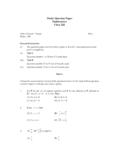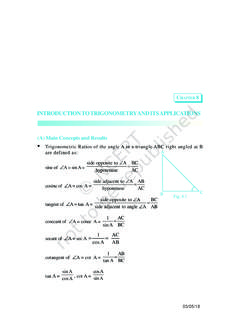Transcription of Analysis of Financial Statements 4 - NCERT
1 You have learnt about the Financial Statements (Income Statement and Balance Sheet) ofcompanies. Basically, these are summarisedfinancial reports which provide the operating resultsand Financial position of companies, and the detailedinformation contained therein is useful for assessingthe operational efficiency and Financial soundnessof a company. This requires proper Analysis andinterpretation of such information for which anumber of techniques (tools) have been developedby Financial experts. In this chapter we will have anoverview of these Meaning of Analysis of Financial StatementsThe process of critical evaluation of the financialinformation contained in the Financial Statements inorder to understand and make decisions regardingthe operations of the firm is called FinancialStatement Analysis .
2 It is basically a study ofrelationship among various Financial facts andfigures as given in a set of Financial Statements , andthe interpretation thereof to gain an insight into theprofitability and operational efficiency of the firm toassess its Financial health and future term Financial Analysis includes both Analysis and interpretation . The term analysismeans simplification of Financial data by methodicalclassification given in the Financial means explaining the meaning andsignificance of the data. These two arecomplimentary to each other. Analysis is uselessLEARNING OBJECTIVESA fter studying this chapter,you will be able to : explain the nature andsignificance of financialanalysis; identify the objectives offinancial Analysis ; describe the various toolsof Financial Analysis ; state the limitations offinancial Analysis ; prepare comparative andcommon size statementsand interpret the datagiven therein.
3 And calculate the trendpercentages and of Financial Statements4without interpretation, and interpretation without Analysis is difficult or statement Analysis is a judgemental process which aims to estimatecurrent and past Financial positions and the results of the operation of anenterprise, with primary objective of determining the best possible estimatesand predictions about the future conditions. It essentially involves regroupingand Analysis of information provided by Financial Statements to establishrelationships and throw light on the points of strengths and weaknesses of abusiness enterprise, which can be useful in decision-making involving comparisonwith other firms (cross sectional Analysis ) and with firms own performance,over a time period (time series Analysis ).
4 Of Analysis of Financial StatementsFinancial Analysis is the process of identifying the Financial strengths andweaknesses of the firm by properly establishing relationships between the variousitems of the balance sheet and the statement of profit and loss. Financial analysiscan be undertaken by management of the firm, or by parties outside the firm,viz., owners, trade creditors, lenders, investors, labour unions, analysts andothers. The nature of Analysis will differ depending on the purpose of the technique frequently used by an analyst need not necessarily serve the purposeof other analysts because of the difference in the interests of the Analysis is useful and significant to different users in the followingways:(a)Finance manager: Financial Analysis focusses on the facts andrelationships related to managerial performance, corporate efficiency, Financial strengths and weaknesses and creditworthiness of the finance manager must be well-equipped with the different tools ofanalysis to make rational decisions for the firm.
5 The tools for analysishelp in studying accounting data so as to determine the continuity of theoperating policies, investment value of the business, credit ratings andtesting the efficiency of operations. The techniques are equally importantin the area of Financial control, enabling the finance manager to makeconstant reviews of the actual Financial operations of the firm to analysethe causes of major deviations, which may help in corrective actionwherever indicated.(b)Top management: The importance of Financial Analysis is not limited tothe finance manager alone. It has a broad scope which includes topmanagement in general and other functional managers. Management ofthe firm would be interested in every aspect of the Financial Analysis .
6 It is177 Analysis of Financial Statements178 Accountancy : Company Accounts and Analysis of Financial Statementstheir overall responsibility to see that the resources of the firm are usedmost efficiently and that the firm s Financial condition is sound. Financialanalysis helps the management in measuring the success of thecompany s operations, appraising the individual s performance andevaluating the system of internal control.(c)Trade payables: Trade payables, through an Analysis of financialstatements, appraises not only the ability of the company to meet itsshort-term obligations, but also judges the probability of its continuedability to meet all its Financial obligations in future. Trade payables areparticularly interested in the firm s ability to meet their claims over avery short period of time.
7 Their Analysis will, therefore, evaluate the firm sliquidity position.(d)Lenders: Suppliers of long-term debt are concerned with the firm s long-term solvency and survival. They analyse the firm s profitability over aperiod of time, its ability to generate cash, to be able to pay interest andrepay the principal and the relationship between various sources of funds(capital structure relationships). Long-term lenders analyse the historicalfinancial Statements to assess its future solvency and profitability.(e)Investors: Investors, who have invested their money in the firm s shares,are interested about the firm s earnings. As such, they concentrate onthe Analysis of the firm s present and future profitability. They are alsointerested in the firm s capital structure to ascertain its influences onfirm s earning and risk.
8 They also evaluate the efficiency of themanagement and determine whether a change is needed or not. However,in some large companies, the shareholders interest is limited to decidewhether to buy, sell or hold the shares.(f)Labour unions: Labour unions analyse the Financial Statements to assesswhether it can presently afford a wage increase and whether it can absorba wage increase through increased productivity or by raising the prices.(g)Others: The economists, researchers, etc., analyse the Financial statementsto study the present business and economic conditions. The governmentagencies need it for price regulations, taxation and other similar of Analysis of Financial StatementsAnalysis of Financial Statements reveals important facts concerning managerialperformance and the efficiency of the firm.
9 Broadly speaking, the objectives ofthe Analysis are to apprehend the information contained in Financial statementswith a view to know the weaknesses and strengths of the firm and to make aforecast about the future prospects of the firm thereby, enabling the analysts totake decisions regarding the operation of, and further investment in the firm. To179 Analysis of Financial Statementsbe more specific, the Analysis is undertaken to serve the following purposes(objectives): to assess the current profitability and operational efficiency of the firmas a whole as well as its different departments so as to judge the financialhealth of the firm. to ascertain the relative importance of different components of thefinancial position of the firm.
10 To identify the reasons for change in the profitability/ Financial positionof the firm. to judge the ability of the firm to repay its debt and assessing theshort-term as well as the long-term liquidity position of the the Analysis of Financial Statements of various firms, an economist canjudge the extent of concentration of economic power and pitfalls in the financialpolicies pursued. The Analysis also provides the basis for many governmentalactions relating to licensing, controls, fixing of prices, ceiling on profits, dividendfreeze, tax subsidy and other concessions to the corporate of Analysis of Financial StatementsThe most commonly used techniques of Financial Analysis are as Statements : These are the Statements showing theprofitability and Financial position of a firm for different periods of time ina comparative form to give an idea about the position of two or more usually applies to the two important Financial Statements , namely,balance sheet and statement of profit and loss prepared in a comparativeform.














